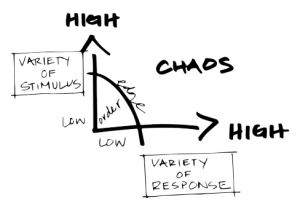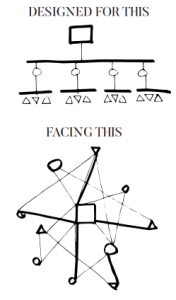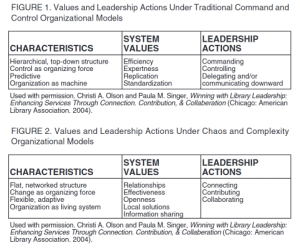Something that really stuck with me in these modules is the concept of chaos always being around to some level. As @michael states in his book, Heart of Librarianship, “hyperlinked library practice is based on the ideas, concepts, and trends of our socio-technological landscape. The hyperlinked librarian understands the following:
– The library is everywhere—it is not just the building or virtual spaces.
– Hyperlinking subverts existing organizational structures.
– Our institutions should be flatter and team-based.
– Seamless service should be available across all channels of interaction.
– We must reach all users, not just those who come through our doors.
– The most powerful information services to date are probably found in the palm of everyone’s hand.
– The path forward will always be an evolutionary one.
– Inevitably, there will always be some amount of chaos.” (Stephens 2016).
When chaos is accepted as part of the inevitable experience of a librarian, change management becomes central to practice. Change and change management is especially centered in the participatory library model described in Library 2.0. The model prioritizes constant and purposeful change, as well as participatory user-driven services, to improve services for new and loyal users (Casey and Savastinuk 2007). Library 2.0 believes that constant and purposeful change is possible and exactly that: constant and purposeful. Casey and Savastinuk continue to say that this is not just change for the sake of change, and that change can be scary, but it doesn’t have to be. If it is baked into the infrastructure, like regular reviewing and updating of services, then it can be helpful and organized to reduce overall stress. That is the overall goal of change management to me; reducing overall stress by having both staff and patrons be open to change as a tool for growth.
When Brian Mathews wrote about cultivating complexity, he brought up change management in the context of teamwork. Mathews writes, “Efficiency is something to strive for when things are stable and predictable, but my environment was volatile, nonlinear, and increasingly complex. This growing awareness caused me to rethink my objectives. Instead of asking ‘how do I manage my time better?’…I needed to get better at understanding how we worked together, not just what we were doing (Mathews 2017).” A lot of change management and accepting chaos requires reframing of conventional thought to more expansive, flexible approaches. With Mathews, the reframing resulted in them rethinking complexity as a multitudinous, non-linear, dynamic, and emergent process. “To operate successfully in a complex environment we must accept that chaos is present and work to develop resilience, allowing it to propel us in seemingly unexpected directions,” (Mathews 2017)


In exploring beyond the readings, I found an article using “swimming upstream” to discuss how the control and command model (more traditional model) feels like an uphill battle. Their article discusses current change theories and gives a model for leading in a world of chaos and change. Their argument is that it better prepares library workers to accept chaos and complexity in their system. What I appreciated most about this article was that it shared similar views as the hyperlinked library model and the practices of library workers within that model, especially leadership. They state, “The leader’s goal needs to shift from trying to control change that is often out of our immediate or direct control, to being opportunistic and responding to change that makes library programs and services adapt-able within our communities for our constituents…Leaders take actions that are situational; they take advantage of change to move and leverage the organization so that it is always positioned for growth and success (Mielke, Singer, and Griffith 2006).”

chaos and complexity model vs traditional model from Mielke et al
References
Casey, M.E. and Savastinuk, L. C. (2007). Library 2.0: A guide to participatory library service. Information Today Inc.
Mathews, C. (2017, September). Cultivating complexity: How I stopped driving the innovation train and started planting seeds in the community garden. Virginia Tech. http://hdl.handle.net/10919/78886
Mielke, L. J., Singer, P. M., & Griffith, G. L. (2007). Swimming upstream. Public Library Quarterly, 25(1-2), 105-116. https://doi.org/10.1300/J118v25n01_08
Stephens, M. (2016). Heart of librarianship. ALA Editions.